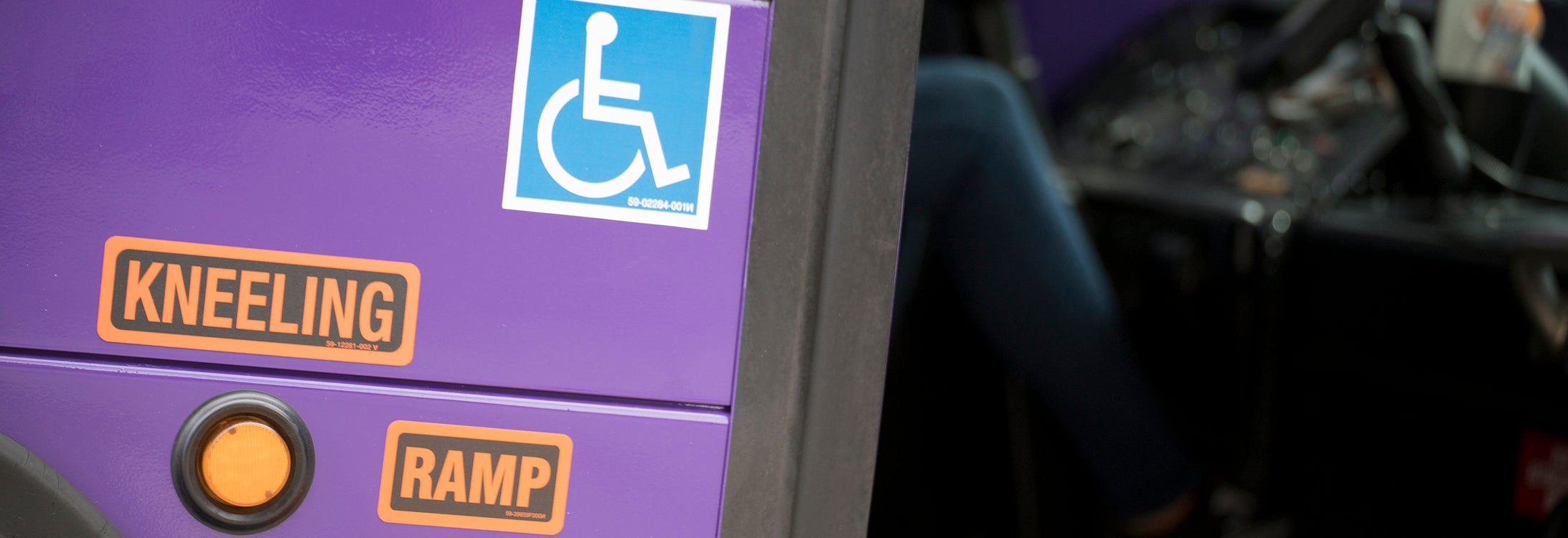Vehicle Features
All vehicles in the ECU Transit fleet have vehicle features designed to aid passengers with disabilities, including those with wheelchairs or other mobility devices. These features may vary from one type of vehicle to another but typically include several of the items described here. You can preview some of these features in the training video under Employee ADA Training.
Many of these features are designed to be used directly by the operator or other trained personnel. For your safety, please do not attempt to operate any equipment yourself. Always allow the operator to assist you with items in the securement area.
Automatic Stop Announcements
As the vehicle approaches a designated stop, announcements are triggered in the passenger area. A digital sign at the front of the passenger area displays the stop which the vehicle is approaching while a pre-recorded voice announces the same information. Additionally, when the doors open at a stop, a pre-recorded voice announces the route name through an exterior speaker.
Destination Signs
Most vehicles carry digital signs on the front, curbside, and rear of the vehicle’s exterior. These signs all display the route name as well as a list of all stops served on the side sign only. The route name is also announced outside when the doors open.
Kneeling Suspension
To make the step up into the bus less of a stretch, kneeling suspension allows the front portion of the bus to be lowered by several inches. Although kneeling suspension is always engaged when using wheelchair ramps, it is not regularly used at every stop. If you have difficulty stepping up into the bus at its normal height, please ask the operator to lower the bus for you.
Wheelchair Ramps
ECU Transit’s fleet of low-floor buses are equipped with ramps to enable the use of wheelchairs, power chairs, and other large mobility devices. Ramps unfold from the front door of the vehicle; please stay clear of the ramp as the operator extends it from the bus. Once unfolded, the ramp should be nearly level when deployed on a curb or at a slight angle when deployed on the street. If you are using a manual wheelchair and need assistance getting up or down the ramp, ask the operator for help.
Wheelchair Lifts
Some vehicles in the fleet are equipped with lifts which extend from the side of the bus through the rear door or a dedicated door of their own. Riders may board facing forward or backward according to their preferences. Always follow the operator’s directions for getting on and off the lift Securement Areas.
The securement areas on each vehicle are equipped with straps to secure wheelchairs and other mobility devices. Operators will attempt to secure your mobility device using four points where possible; you may be asked which points on your particular device are sturdy enough to accept the hook at the end of the strap. Accessible stop request buttons or strips are located in the securement areas so you can alert the operator as you approach your destination.
Securement Areas
The securement areas on each vehicle are equipped with straps to secure wheelchairs and other mobility devices. Operators will attempt to secure your mobility device using four points where possible; you may be asked which points on your particular device are sturdy enough to accept the hook at the end of the strap. Accessible stop request buttons or strips are located in the securement areas so you can alert the operator as you approach your destination.
Priority Seating
When boarding during peak times, you may find the bus is already carrying riders in the priority seating areas. If other seats or standing room are available, operators may request riders give up their seats in these areas but cannot force them to do so.
